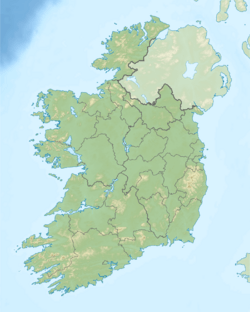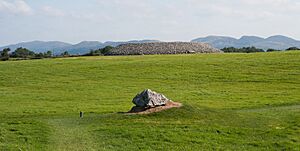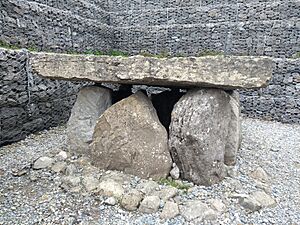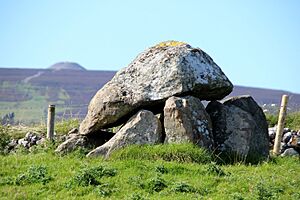Carrowmore facts for kids
|
An Cheathrú Mhór
|
|
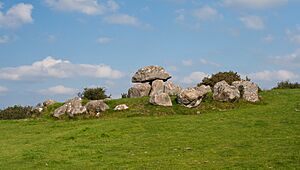
Tomb 7, a dolmen within a stone circle; one of the Carrowmore 'satellite tombs'.
|
|
| Location | County Sligo, Ireland |
|---|---|
| Region | Atlantic Megalithic Zone |
| Coordinates | 54°15′03.08″N 8°31′09.00″W / 54.2508556°N 8.5191667°W |
| Type | Passage tomb complex |
| History | |
| Material | Gneiss, limestone |
| Founded | 3700–2900 BC |
| Periods | Neolithic |
| Cultures | Neolithic Europe |
| Site notes | |
| Excavation dates | 1977–1980, 1994–1998 |
| Condition | Partially preserved |
| Ownership | Public and private |
| Management | Admission Fee |
| Public access | Yes |
| Official name | Carrowmore Passage Tomb Cemetery |
| Reference no. | 153 |
Carrowmore (which means 'the great quarter' in Irish) is a huge collection of ancient monuments made from large stones, called megalithic monuments. You can find them on the Coolera Peninsula in County Sligo, Ireland. These amazing structures were built a very long time ago, between 3700 and 2900 BC, during the Neolithic period, also known as the New Stone Age.
There are 30 tombs still standing today, but many more have been lost over time. This makes Carrowmore one of the biggest groups of ancient tombs in Ireland. It's considered one of the 'big four' important sites, along with Carrowkeel, Loughcrew, and Brú na Bóinne. Carrowmore is at the heart of a special ancient area, with the impressive Knocknarea mountain nearby. It is a protected National Monument, meaning it's a very important part of Ireland's history.
Contents
What is Carrowmore?
Carrowmore is a collection of ancient burial sites, mostly passage tombs, which are a type of tomb with a narrow passage leading to a central chamber. These tombs were built by early farming communities in Ireland. They are not just simple graves; they were important places for ceremonies and remembering ancestors.
Where is Carrowmore Located?
Carrowmore sits on a small, flat area of land that is between 36.5 and 59 meters above sea level. It's a central spot in an ancient landscape that was important for ceremonies. To the west, you can see the large Knocknarea mountain, which has a huge stone mound called Miosgán Médhbh on its top. To the east, two other large mounds look over Lough Gill. The Ballygawley Mountains also have four passage tombs on their peaks.
What Do the Tombs Look Like?
Today, 30 monuments remain at Carrowmore. There might have been more originally, but some were destroyed by quarrying (taking stone) and clearing land in the past. The whole area of the complex is about one kilometer long from north to south and 600 meters wide from east to west. Most of the sites are "satellite tombs," meaning they are smaller tombs that surround the largest monument. This main monument, called Listoghil, is on the highest point of the plateau and has been restored.
Carrowmore's tombs are part of what archaeologists call the Irish Passage Tomb Tradition. This means they share features with other famous sites like Newgrange and Carrowkeel. However, Carrowmore's tombs are a bit different. For example, most of them don't have the long, tunnel-like passages found in other Irish passage tombs. Also, only one site, Listoghil (Tomb 51), has a large stone mound, called a cairn, covering it.
The Smaller Satellite Tombs
The smaller tombs, in their original form, had a central stone structure that looked like a dolmen. This structure had five upright stones, called orthostats, holding up a roughly cone-shaped capstone. This created a small, five-sided burial chamber inside. Each of these central structures was surrounded by a circle of large boulders, usually 12 to 15 meters across. These boulder circles typically contained 30 to 40 large stones, often made of gneiss. Sometimes, there was even a second, inner circle of boulders.
Stones leading from the central tomb showed the direction it was meant to face. These tombs generally faced towards the area of the central cairn, Listoghil, rather than specific compass points. Some of the monuments are even found in pairs. Each tomb was built on a small, flat platform of earth and stone. This careful construction, with stones packed around the base of the uprights, helped the tombs last for thousands of years. One of these smaller tombs, Tomb 27, has a cross-shaped passage, a design seen in later, larger passage tombs.
Listoghil: The Main Tomb
Listoghil, also known as Tomb 51, was built around 3500 BC. It is 34 meters wide and has a unique box-like chamber. The stone covering the entrance has marks that might be the only ancient art found at Carrowmore so far. Three large boulders were found near the central chamber and under the cairn. These might be parts of an older structure or a destroyed passage. Since many of the smaller tombs face Listoghil, it seems this monument was the main focus around which the entire cemetery grew. This tomb contained both unburned bones and cremated (burned) remains.
How Do We Know About Carrowmore's Past?
People have been interested in Carrowmore for a long time. Early explorers and archaeologists have helped us understand its history.
Early Explorers and Digs
Gabriel Beranger visited Carrowmore in 1779 and drew some of the monuments. His drawings are very important because they show what the site looked like back then, including some monuments that are now gone or damaged. Many artists have drawn Carrowmore over the centuries. Early photographers also took pictures of the site in the early 1900s.
In the 1800s, some local landowners, like Rodger Walker, dug into the tombs. However, they didn't keep good records, and their digs were mostly to find treasures for their collections. Some items found by Walker are now in Alnwick Castle in England. The sites were properly surveyed and numbered by George Petrie in 1837. The first recorded archaeological digs were done by William Gregory Wood-Martin in the 1880s.
Modern Discoveries and Science
More recently, a Swedish archaeologist named Göran Burenhult led excavations from 1977 to 1982 and again from 1994 to 1998. During these digs, ten tombs were fully or partly excavated, including Listoghil (Tomb 51) between 1996 and 1998. Other digs nearby have shown that an ancient fenced area, called a causewayed enclosure, existed at the same time as Carrowmore. These enclosures are a sign of Neolithic activity in Europe.
What Did They Find?
The items found in Carrowmore's tombs are typical of Irish passage tombs. They include pins made from antler and bone with mushroom-shaped heads, beads, pendants, and small balls made of stone or clay. Many burials also contained pieces of quartz, which seems to have been important in ancient ceremonies. Finding antler pins and seashells might suggest that the earliest tombs were built by people who hunted and gathered food. However, small amounts of Neolithic pottery also suggest that farming was already happening.
The chambers held the remains of many people. Most of the Neolithic burials at Carrowmore were cremations, meaning the bodies were burned. People from the Bronze Age and Iron Age also reused the chambers later for burials and to leave items. It seems that the smaller Carrowmore tombs were not covered by large stone mounds, or cairns, as some earlier researchers thought.
Dating the Tombs
Scientists use radiocarbon dating to find out how old things are. Dates from the Carrowmore digs in the 1970s, 80s, and 90s caused some debate. Professor Göran Burenhult first thought the dates showed the monuments were built by hunter-gatherers. However, after more research and 25 new radiocarbon dates, it's now believed that the Carrowmore monuments were built and used between about 3750 BC and 3000 BC. Studies of ancient environments in nearby lakes also support this, showing that farming was happening around the same time the monuments were used.
Ancient DNA Clues
Scientists have even studied ancient DNA from human bones found in these tombs. This research shows connections between people buried in different Irish passage tombs. For example, a man buried in Listoghil at Carrowmore was related to three other people buried in Newgrange, Millin Bay, and Carrowkeel. This suggests that important families or leaders might have been buried in these special places during the Neolithic period.
Why is Carrowmore Important?
Research at Carrowmore has helped us understand when and how passage tombs developed in Ireland. It's possible that Carrowmore has some of the very first passage tombs built in the country. Ancient genetic studies now suggest that farming communities spread from a place called Anatolia a long time ago. Archaeologists believe that these large stone monuments were important for ceremonies and celebrations. They also served as memorials for important families or individuals.
Carrowmore was a starting point and a central place in the Neolithic landscape. The building of very large stone mounds, like Listoghil or Miosgán Médhbh on Knocknarea, might represent a later time when people built even bigger and more impressive monuments. The area around Carrowmore is full of these tombs, often on hilltops, which led one archaeologist to call it the "Landscape of the Monuments."
Protecting Carrowmore's History
In the 1980s, Carrowmore faced a challenge. In 1983, the local council wanted to build a rubbish dump very close to the ancient site. Five local people took the council to court to stop this. After a long legal battle, the Supreme Court ruled against the council in 1989. This was a very important decision because it was the first time that the law officially recognized the idea of an "architectural landscape." This meant that the legal protection of a national monument could also include the important area around it, not just the monument itself.
Visiting Carrowmore Today
To help people visit and learn about Carrowmore, the Irish government bought about 25 acres of land there in 1989-90. This land included several monuments and a small cottage. The cottage was turned into a visitor center run by the Office of Public Works. This was the first step in making Carrowmore accessible to the public. Now, most of the site is owned by the public.
The visitor center is near the R292 road. It has an exhibition and offers guided tours from March to the end of October. You can also get self-guide options in different languages. From the visitor center, you can easily reach most of the ancient tombs.


